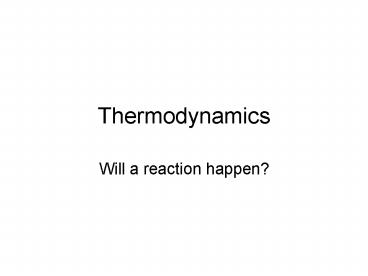Thermodynamics - PowerPoint PPT Presentation
1 / 17
Title: Thermodynamics
1
Thermodynamics
- Will a reaction happen?
2
Energy
- Substances tend to react to achieve the lowest
energy state. - Most chemical reactions are exothermic.
- Doesnt work for things like ice melting.
- An ice cube must absorb heat to melt, but it
melts anyway. Why?
3
Entropy
- The degree of randomness or disorder.
- S
- Drop a box of marbles.
- Watch your room for a week.
4
Entropy
Entropy of a solid
Entropy of a liquid
Entropy of a gas
- A solid has an orderly arrangement.
- A liquid has the molecules next to each other.
- A gas has molecules moving all over the place.
5
Entropy increases when...
- Reactions of solids produce gases or liquids, or
liquids produce gases. - A substance is divided into parts -so reactions
with more reactants than products have an
increase in entropy. - the temperature is raised -because the random
motion of the molecules is increased. - a substance is dissolved.
6
Entropy calculations
- There are tables of standard entropy.
- Standard entropy is the entropy at 25ºC and 1
atm pressure. - Abbreviated Sº, measure in J/K.
7
Spontaneity
- Will the reaction happen, and how can we make it?
8
Spontaneous reaction
- spontaneous reactions will happen.
- nonspontaneous reactions dont.
- Two factors influence.
- Enthalpy (heat) and entropy(disorder).
9
Two Factors
- Exothermic reactions tend to be spontaneous.
- -negative DH.
- -Reactions where the entropy of the products is
greater than reactants tend to be spontaneous. - Positive DS.
- -A change with positive DS and negative DH is
always spontaneous. - -A change with negative DS and positive DH is
never spontaneous.
10
Other Possibilities
- Temperature affects entropy.
- Higher temperature, higher entropy.
- For an exothermic reaction with a decrease in
entropy (like rusting). - Spontaneous at low temperature.
- Nonspontaneous at high temperature.
- Entropy driven.
11
Other Possibilities
- An endothermic reaction with an increase in
entropy like melting ice. - Spontaneous at high temperature.
- Nonspontaneous at low temperature.
- Enthalpy driven.
12
Gibbs Free Energy
- The energy free to do work is the change in Gibbs
free energy. - DGº DHº - TDSº (T must be in Kelvin)
- All spontaneous reactions release free energy.
- If DG lt0 for a spontaneous reaction.
- DG 0 reaction is at equilbrium
- DG gt0 for a non spontaneous reaction.
13
DGDH-TDS
Spontaneous?
DH
DS
DG
At all Temperatures
At high temperatures, entropy driven
At low temperatures, enthalpy driven
Not at any temperature, Reverse is spontaneous
14
2H2S(g) O2(g) 2H2O(l) 2 S
- Find ?G if
- ?H is 531.4 kJ and ?S is 412 J/K
- at 25 C.
- Change the temperature to Kelvin
- 25 273 298
15
2H2S(g) O2(g) 2H2O(l) 2 S
- ?G ?H - T ?S
- ?G -531.4 kJ - 298K (-412.5 J/K)
- ?G -531.4 kJ 123000 J
- ?G -531.4 kJ 123 kJ
- ?G -408.4 kJ
- Spontaneous
- Exergonic- it releases free energy.
16
- Find ?G if ?H is 366 kJ and ? S is 340 kJ/K at
a temp of 38C. - Change temp to Kelvin
- 38 273 311 K
- ?G ?H -T ?S
- -366 kJ (311K) ( 340kJ/K)
- -106106 kJ
- - 110000 kJ
17
- Assignment
- p 948 488, 489,491
- P 548 24,25
- P 549 31

















![L 18 Thermodynamics [3] PowerPoint PPT Presentation](https://s3.amazonaws.com/images.powershow.com/6877662.th0.jpg?_=20150709116)













